
Australian Geomechanics Journal
Scope & Guideline
Shaping the Future of Sustainable Geotechnical Practices
Introduction
Aims and Scopes
- Geotechnical Analysis and Design:
The journal extensively covers methodologies for analyzing and designing geotechnical structures, including stability assessments, load-bearing capacity evaluations, and settlement predictions. - Ground Improvement Techniques:
Research related to ground improvement methods, such as dynamic compaction, use of stabilizing agents, and innovative materials, is a core focus, addressing challenges in soil behavior and performance. - Environmental and Climatic Impacts:
Studies examining the influence of environmental factors, such as climate change on soil mechanics and the performance of geotechnical structures, are increasingly prominent, reflecting a growing awareness of sustainability. - Field and Laboratory Testing:
The journal emphasizes empirical research based on field and laboratory testing to validate theoretical models and improve the reliability of geotechnical engineering practices. - Risk Assessment and Management:
There is a strong focus on risk assessment methodologies, particularly in relation to landslides, subsidence, and other geohazards, highlighting the importance of safety and reliability in geotechnical engineering.
Trending and Emerging
- Numerical Modeling and Simulation:
There is a growing trend towards the use of advanced numerical modeling techniques to simulate complex geotechnical problems, which allows for better predictions and understanding of soil-structure interactions. - Sustainable and Green Technologies:
Research on sustainable practices in geotechnics, including the use of recycled materials and eco-friendly stabilization methods, is gaining traction, highlighting a shift towards environmentally responsible engineering. - Geotechnical Monitoring and Instrumentation:
The increasing use of sophisticated monitoring tools and instrumentation for real-time data collection is a prominent theme, emphasizing the importance of data-driven decision-making in geotechnical engineering. - Collaboration between Academia and Industry:
There is a notable increase in studies that showcase collaborative efforts between academic institutions and industry practitioners, aiming to bridge the gap between theory and practice. - Impact of Climate Change on Geotechnics:
Research addressing the implications of climate change on soil behavior and geotechnical design is becoming more prevalent, reflecting a heightened awareness of environmental factors in geotechnical engineering.
Declining or Waning
- Traditional Soil Mechanics:
While foundational topics in soil mechanics remain important, there seems to be a waning interest in purely theoretical studies without practical implications, as more applied research is sought after. - Historical Case Studies:
There has been a noticeable decrease in the publication of historical case studies that do not incorporate modern methodologies or technological advancements, reflecting a shift towards contemporary challenges. - Simplified Models for Complex Problems:
Research that relies on overly simplified models without addressing the complexities of real-world geotechnical issues appears to be less frequent, as the field evolves towards more nuanced approaches.
Similar Journals
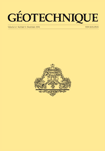
GEOTECHNIQUE
Elevating Geotechnical Practices Through Groundbreaking ResearchGEOTECHNIQUE is a prestigious peer-reviewed journal published by Emerald Group Publishing Ltd, specializing in the fields of Geotechnical Engineering and Earth and Planetary Sciences. Established in 1948, this journal has consistently delivered groundbreaking research and advancements in the science of soil and rock mechanics, engineering geology, and environmental applications, aiming to foster innovation in geotechnical practices. With an impressive impact factor reflected in its Q1 ranking within both the Earth and Planetary Sciences and Geotechnical Engineering categories, GEOTECHNIQUE is recognized as a leading source of scholarly articles, positioning itself among the top 5% in the field. The journal is accessible via subscription, providing a repository of invaluable insights for researchers, professionals, and students striving to push the boundaries of knowledge and application in geotechnical topics. With a robust editorial board and a commitment to excellence, GEOTECHNIQUE continues to contribute significantly to the academic community and the practical engineering landscape.
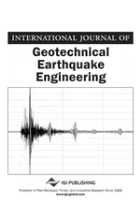
International Journal of Geotechnical Earthquake Engineering
Fostering collaboration in the quest for earthquake-resistant structures.International Journal of Geotechnical Earthquake Engineering, published by IGI Global, serves as a pivotal platform for researchers and practitioners in the field of geotechnical engineering and engineering geology. Established in 2010, this journal has steadily promoted the dissemination of innovative research and advancements in understanding the impact of seismic activities on soil behavior and structural integrity. Operating out of the United States, it caters to a global audience and offers a range of articles that delve deep into the dynamics of earthquake engineering. With a 2023 Scopus ranking placing it in the 39th percentile among its peers and a Q4 designation in the relevant quartile, the journal actively seeks to elevate the discussion around geotechnical challenges associated with seismic events. While currently not classified as an Open Access journal, it remains committed to providing valuable insights that aid in the prevention and mitigation of geotechnical failures during earthquakes. Researchers, professionals, and students alike will find this journal an essential resource for the latest developments and practical applications in this ever-evolving field.
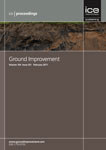
Proceedings of the Institution of Civil Engineers-Ground Improvement
Driving Research for Sustainable Building PracticesProceedings of the Institution of Civil Engineers-Ground Improvement is a distinguished journal published by EMERALD GROUP PUBLISHING LTD, dedicated to advancing knowledge and research in the fields of Building and Construction, Geotechnical Engineering, Mechanics of Materials, and Soil Science. With an ISSN of 1755-0750 and an E-ISSN of 1755-0769, this journal has been a vital platform for disseminating innovative research since its inception in 2008. With an impact factor placing it in the Q3 category across multiple engineering disciplines, it ranks favorably in Scopus, ensuring visibility and recognition among scholars globally. The journal offers open access options, allowing for broader dissemination of research findings. Targeting researchers, professionals, and students alike, it aims to foster discussions on ground improvement technologies and methodologies that are essential for sustainable infrastructure development. As it continues to converge its focus until 2024, the Proceedings stands as an imperative resource for those seeking to elevate their understanding and contribute to the ever-evolving field of civil engineering.
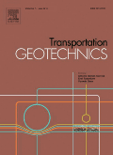
Transportation Geotechnics
Advancing the Future of Infrastructure Stability.Transportation Geotechnics is a premier academic journal published by Elsevier, focusing on the intersection of geotechnical engineering and transportation systems. With an impressive impact factor and categorized in the Q1 quartile across multiple disciplines including Civil and Structural Engineering, Geotechnical Engineering, and Transportation, this journal stands as a vital resource for researchers and practitioners alike. It covers a broad spectrum of topics ranging from soil behavior in transport contexts to innovative materials and methods that enhance infrastructure stability and performance. As an essential platform fostering knowledge dissemination, Transportation Geotechnics enables contributors to share their groundbreaking findings while providing readers with access to cutting-edge research and reviews from 2014 to 2024. Its illustrious Scopus rankings place it prominently in the global research landscape, making it an indispensable tool for students, professionals, and academics dedicated to advancing the field.
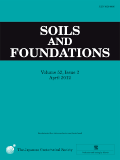
Soils and Foundations
Elevating civil engineering through innovative soil research.Soils and Foundations, an esteemed journal published by the Japanese Geotechnical Society, has established itself as a pivotal platform for innovative research in Civil and Structural Engineering and Geotechnical Engineering. With an impressive impact factor reflected in its Q1 quartile ratings for both disciplines, the journal provides critical insights that foster advancements in the understanding of soil behavior and foundation design. Since its transition to Open Access in 2020, Soils and Foundations has broadened its reach, ensuring accessible dissemination of knowledge to researchers, students, and professionals globally. With a rich history dating back to its inception in 1960, the journal continues to uphold a high standard of scholarly excellence, ranking within the top percentile in Scopus across geotechnical engineering fields. This commitment to quality and accessibility makes it an essential resource for anyone engaged in the vital areas of soil mechanics and foundation engineering.

ROCK MECHANICS AND ROCK ENGINEERING
Transforming Geological Insights into Engineering SolutionsROCK MECHANICS AND ROCK ENGINEERING, published by SPRINGER WIEN, stands as a premier journal in the fields of civil and structural engineering, geology, and geotechnical engineering. Since its inception in 1983, this journal has evolved into a leading platform for the dissemination of high-quality research, underscored by its impressive Q1 quartile rankings in multiple relevant categories as of 2023. With a significant impact factor and a ranking of 8th out of 321 in Earth and Planetary Sciences (Geology), the journal attracts scholars and practitioners aiming to contribute to and stay abreast of advancements in rock mechanics and engineering practices. While it does not offer Open Access options, its comprehensive and rigorous peer-reviewed articles serve as essential resources for fostering knowledge and innovation in the sector. The commitment to exploring the interactions between geological materials and engineering applications makes this journal indispensable for researchers, professionals, and students dedicated to pushing the boundaries of these critical fields.

Bulletin of Engineering Geology and the Environment
Bridging theory and practice in the geological sciences.Bulletin of Engineering Geology and the Environment, published by SPRINGER HEIDELBERG, is a leading journal dedicated to the fields of Geology, Geotechnical Engineering, and Engineering Geology. With an impressive impact factor placing it in the Q1 category for both geology and geotechnical disciplines, this journal is recognized for its significant contributions to the knowledge and application of engineering geology practices. Since its inception in 1984, the Bulletin has provided a platform for researchers and professionals to share cutting-edge research, case studies, and innovative methodologies relevant to the challenges of understanding and managing geological environments. With a robust Scopus ranking—#32/321 in Geology and #43/229 in Geotechnical Engineering—this journal is an essential resource for academics and industry leaders alike, striving to advance the environmental engineering field. For those interested in accessing the latest research and developments, the Bulletin fosters a collaborative and informed scholarly community.
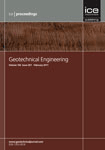
PROCEEDINGS OF THE INSTITUTION OF CIVIL ENGINEERS-GEOTECHNICAL ENGINEERING
Connecting Theory and Practice in Geotechnical InnovationsPROCEEDINGS OF THE INSTITUTION OF CIVIL ENGINEERS-GEOTECHNICAL ENGINEERING, published by Emerald Group Publishing Ltd, is a prestigious journal that serves the dynamic field of geotechnical engineering and broader earth sciences. With an ISSN of 1353-2618 and an E-ISSN of 1751-8563, this journal has established itself as a vital resource for researchers, professionals, and students alike, offering insights into innovative practices and developments within the geotechnical domain. It ranks within the Q2 category for Earth and Planetary Sciences and Geotechnical Engineering as of 2023, demonstrating its significant impact and relevance in these fields. Given its comprehensive scope from 1994 to 2024, the journal provides a platform for high-quality research articles, case studies, and technical notes, although it presently does not offer open access options. Researchers seeking to publish their work will find this journal an essential venue for reaching an audience deeply invested in the advancement of geotechnical methodologies and solutions.

Transportation Infrastructure Geotechnology
Pioneering Research in Infrastructure Sustainability and Safety.Transportation Infrastructure Geotechnology, an esteemed journal published by SpringerNature, serves as a vital platform in the fields of Civil and Structural Engineering, Environmental Engineering, Geotechnical Engineering, and Transportation. Established in 2014 and spanning a decade of significant scientific discourse, this journal has gained recognition for its robust contribution to the understanding of the interplay between geotechnical processes and transportation infrastructure. With an impactful Q2 ranking in multiple categories—including Civil and Structural Engineering and Environmental Engineering—it emphasizes innovative research and practical applications globally. Researchers and professionals can explore critical topics that influence infrastructure sustainability, safety, and efficiency. Although it operates under a subscription model, its affiliation with SpringerNature ensures rigorous peer-review and high-quality publications, making it an indispensable resource for academics and industry experts alike.

Geotechnique Letters
Catalyzing Knowledge in Earth and Planetary Sciences.Geotechnique Letters is a prestigious journal published by Emerald Group Publishing Ltd, with a focused dedication to advancing the field of geotechnical engineering and engineering geology. Since its inception in 2011, the journal has rapidly established itself as a leading platform for disseminating high-quality research and innovative practices, earning a stellar Q1 ranking in both Earth and Planetary Sciences (miscellaneous) and Geotechnical Engineering categories as of 2023. With an ISSN of 2049-825X and E-ISSN 2045-2543, this journal captures vital insights and cutting-edge developments that cater to researchers, industry professionals, and students passionate about geotechnical challenges. Although it operates under a subscription model, the journal offers options for authors to publish their work—enhancing accessibility for those seeking to share knowledge within the community. The Scopus rankings place it comfortably within the top echelons of its field, affirming its importance and influence in shaping the future of geotechnical research and practice. With converged years extending to 2024, Geotechnique Letters is positioned as an essential resource for anyone looking to stay atop advancements and discussions in geotechnical sciences.